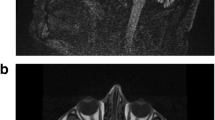Abstract
Childhood-onset neurodegeneration with cerebellar atrophy (CONDCA) is a recently described form of the large group of infantile hereditary lower motor neuron diseases (Teoh et al. 2017), resulting from biallelic damaging variants in the AGTPBP1 gene, first described by Shashi et al. in EMBO J 37(23):e100540, 2018. AGTPBP-related neurodegeneration is a severe neurodevelopmental disorder that progresses with global developmental delay and intellectual disability, often accompanied with peripheral nerve damage and lower motor degeneration and a fatal course in the early years of life. The encoded protein is ATP/GTP-Binding Protein1, also known as cytosolic carboxypeptidase 1 (CCP1) or nervous system nuclear protein induced by axotomy (NNA1). Here we report a consanguineous family with four offspring, two of whom are affected. The index patient is a 21-month-old male with global developmental delay and hypotonia. The proband’s 17-year-old sister, diagnosed with cerebral palsy, had severe hypotonia accompanied by motor and cognitive retardation. WES analysis revealed a novel homozygous c.3293G > A variant in the AGTPBP1 gene with high pathogenicity scores. Targeted Sanger sequencing confirmed the variant in both affected children and in heterozygous form in the parents. The affected siblings present with hypotonia and motor and cognitive retardation, in line with the studies previously reported. However, in our patients, no signs of cerebellar atrophy in cranial MRI were present, so the acronym CONDCA is not applicable; lower motor neuron findings were also absent. The matching and distinguishing aspects of our patients will add to the present literature and expand our understanding of this rare genetic neurodegenerative disease of early childhood.

Similar content being viewed by others
References
Rogowski K, van Dijk J, Magiera MM et al (2010) A family of protein-deglutamylating enzymes associated with neurodegeneration. Cell 143:564–578
Kitano S, Kino Y, Yamamoto Y et al (2015) Bioinformatics data mining approach suggests coexpression of AGTPBP1 with an ALS-linked gene C9orf72. J Cent Nerv Syst Dis 7:15–26
Shashi V, Magiera MM, Klein D et al (2018) Loss of tubulin deglutamylase CCP1 causes infantile-onset neurodegeneration. EMBO J 37(23):e100540
Sheffer R, Gur M, Brooks R et al (2019) Biallelic variants in AGTPBP1, involved in tubulin deglutamylation, are associated with cerebellar degeneration and motor neuropathy. Eur J Hum Genet 27(9):1419–1426
Karakaya M, Paketci C, Altmueller J et al (2019) Biallelic variant in AGTPBP1 causes infantile lower motor neuron degeneration and cerebellar atrophy. Am J Med Genet 179(8):1580–1584
Fernandez-Gonzalez A, La Spada AR, Treadaway J et al (2002) Purkinje cell degeneration (PCD) phenotypes caused by mutations in the axotomy-induced gene, Nna1. Science 295:1904–1906
Zhao X, Onteru SK, Dittmer KE et al (2012) A missense mutation in AGTPBP1 was identified in sheep with a lower motor neuron disease. Heredity 109:156–162
Anderson PD, Parton KH, Collett MG, Sargison ND, Jolly RD (1999) A lower motor neuron disease in newborn Romney lambs. N Z Vet J 47:112–114
Monies D, Abouelhoda M, Al Sayed M et al (2017) The landscape of genetic diseases in Saudi Arabia based on the first 1000 diagnostic panels and exomes. Hum Genet 136:921–939
Acknowledgements
This study was completed in collaboration between the Pediatric and Genetic Medicine Departments of the Düzce University Medical Faculty and Koç University School of Medicine, KUTTAM-NDAL. Gülşah Şimşir, Şeyma Tekgül, and Maja Haerle are acknowledged for excellent technical and editorial assistance and Robin J. Palvadeau for bioinformatics support. We would like to thank all staff and the family for participating in this study.
Funding
ANB’s research is funded by Suna and Inan Kıraç Foundation and Koç University School of Medicine.
Author information
Authors and Affiliations
Corresponding author
Ethics declarations
Conflict of interest
The authors declare no competing interests.
Additional information
Publisher's Note
Springer Nature remains neutral with regard to jurisdictional claims in published maps and institutional affiliations.
Rights and permissions
About this article
Cite this article
Türay, S., Eröz, R. & Başak, A.N. A novel pathogenic variant in the 3ʹ end of the AGTPBP1 gene gives rise to neurodegeneration without cerebellar atrophy: an expansion of the disease phenotype?. Neurogenetics 22, 127–132 (2021). https://doi.org/10.1007/s10048-021-00643-8
Received:
Accepted:
Published:
Issue Date:
DOI: https://doi.org/10.1007/s10048-021-00643-8




